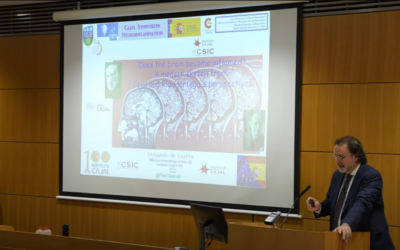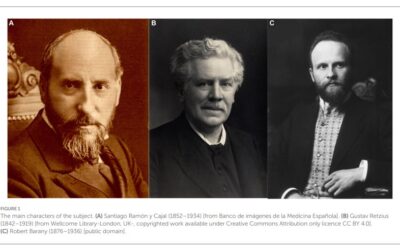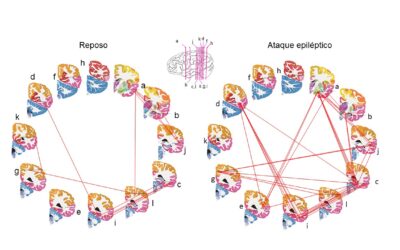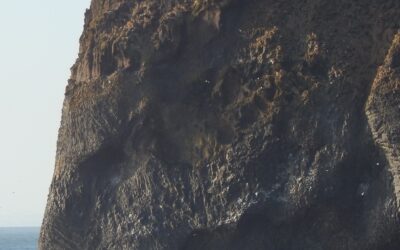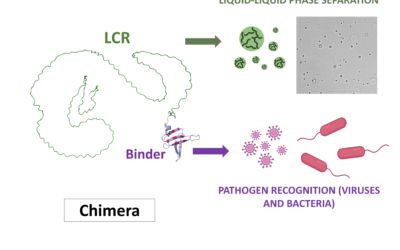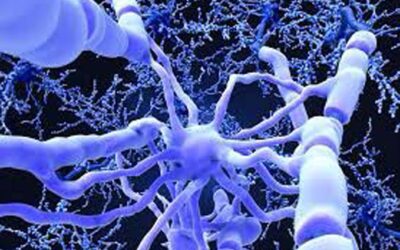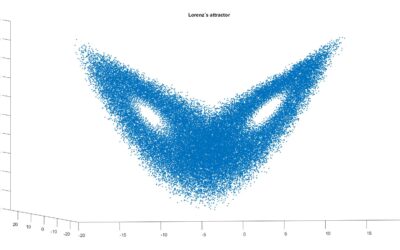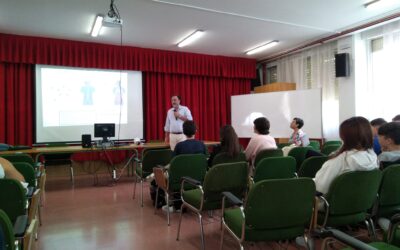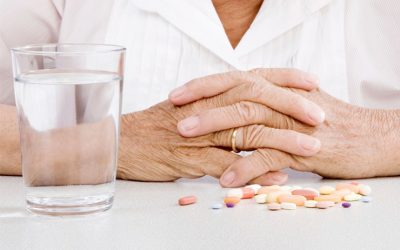DIFFUSION
News
NEWS
Here you will find all the news related to the Cajal Institute, its researchers and discoveries in neuroscience
Inauguration of CNC (which will include Cajal Institute) in its location in Alcalá de Henares
Inauguration of Cajal Neurosciences Center (which will include Cajal Institute) in its new location in Alcalá de Henares.
Cajal symposium: Neuroinflammation
Cajal Symposium: Neuroinflammation (Dublín, Irlanda, 7th November 2024), now available in YouTube.
Cajal, identified as pioneer of the vestibular system in… 2024…!
A recent investigation has identified the chronology of the discoveries made by Santiago Ramón y Cajal (1852-1934) in the vestibular system, and put under the light correspondance demonstrating its capital role for other pioneer researchers like Bárány to describe the structural and physiological basis of this part of the Central Nervous System. This is a clear demonstration of the need to study old archives like the Legado Cajal
Pioneering application separating deep neural sources in humans to accurately mark epileptic foci and avoid false positives
Intracranial recordings (stereo-EEG) are revolutionizing the diagnosis and treatment of some persistent neuropathologies, such as epilepsy and Parkinson’s disease.
Premiere of the short film ‘Cajal libremente’ (‘Cajal freely’), from José Luis Trejo and Sergio Lara
Premiere of the short film ‘Cajal libremente’ (‘Cajal freely’), from Sergio Lara and Dr. José Luis Trejo, researcher in Cajal Institute, co-produced by CSIC, and based in life and works of Ramón y Cajal.
Today is a day to celebrate. The creation of the Cajal Museum has been achieved.
The Cajal Museum has been established as a National Museum owned by the state, under the Ministry of Science, Innovation, and Universities through the Spanish National Research Council (CSIC).
Two authors from Cajal Institute publish an article about pareidolia in CSIC blog in 20minutes newspaper.
Miriam Caro and Emilio Tejera write an article (Pareidolia: I sometimes see faces) in CSIC blog in 20minutes newspaper ‘Science to take away’.
Two innovations derived from the European PathoGelTrap project selected by Innovation Radar
Two innovations patented by the Laboratory of Dr. Mariano Carrión-Vázquez of the Cajal Institute have been selected as “excellent innovations” by the Innovation Radar, an instrument of the European Commission to promote technology transfer.
ALLIES program in search for postdoctoral researchers
ALLIES program in AI development, in which Cajal Institute participates, is looking for postdoctoral researchers
You can already reserve activities for Brain Awareness Week 2024 in Cajal Institute
A neuroconcert, a neuroflamenco workshop and a debate about neuroscience and cinema: you can already reserve divulgation activities by Brain Awareness Week 2024 in Cajal Institute
The Legacy of Santiago Ramón y Cajal, available on the Simurg portal
A significant portion of the 28,000 assets comprising the scientist’s legacy can already be consulted in the Cajal Space.
The neurodeck of cards from Cajal Institute can already be acquired in the Natural Sciences National Museum (MNCN) shop
The neurodeck of cards from Cajal Institute can already be acquired in the Natural Sciences National Museum (MNCN) shop Cajal Institute - NewsProbably some of you know about the neurodeck of cards of Cajal Institute, if you have alredy seen the publications about it...
New remyelinizing compounds for the unmade challenge in Multiple Sclerosis
Two recent articles from the Instituto Cajal offer new perspectives for developing remyelinating treatments for multiple sclerosis and other demyelinating diseases: a very important pending subject of modern Neurology.
Fractal analysis allows to characterize the multi-source electrical activity of the brain without previous de-mixing of its sources
Characterization of the temporal structure of intracranial field potentials by fractal analysis.
Conference in Rome: ‘Romans are crazy!’, or how peplum cinema has talked about mental disorders
Announcement of the conference in the Spanish School of History and Archeology in Rome: ‘Romans are crazy!’, by Emilio Tejera, from Cajal Institute.
Biomathematical technique optimized in animals reveals the evolution of brain damage in different cortical layers of patients after stroke.
When a person suffers a cerebrovascular accident (a stroke or a subarachnoid hemorrhage), electrochemical waves are generated that slowly travel through the tissue from the damaged area, killing neurons as they pass.
The CSIC (Spanish National Research Council) and Zahorí Books launch a collection of illustrated books for the younger audience.
The collection ‘Mentes Curiosas, Curiosas Mentes’ debuts with ‘Oler,’ a title by Berta Páramo that has benefited from the expertise of scientist Laura López-Mascaraque.”
Study reveals the structure of brain waves associated with memory consolidation
Diseases like as Alzheimer’s and epilepsy affect this type of memory, which represents the person’s experiences and life story.
Registration is now open for the activities of the 2023 Science Week at the Cajal Institute
This year at the Cajal Institute, from November 6th to 19th, we have multiple activities that are as informative as they are fun.
Ciudad Ciencia addresses mental health in a workshop with adolescents
“‘How to understand and manage our emotions’ will provide tools to secondary education (ESO) and vocational training (FP) students to develop good emotional intelligence.”
Since its foundation, scientists at the Cajal Institute have focused their research on Alzheimer’s disease
Two important events in the history of neuroscience occurred in 1906.
Exploring Alzheimer’s Through Science, Cinema, and More: A Multidimensional Journey on World Alzheimer’s Day
Emilio Tejera discusses ‘Alzheimer’s Disease through Science, Cinema, and Other Perspectives’ in the lecture he will give today at the Spanish School of History and Archaeology in Rome – CSIC
Pioneering study finds that brain tumours affects neuronal activity specifically.
We report a comprehensive multidimensional modeling of brain functional analyses in the context of brain metastasis.
Modulation of brain electrical activity as a mechanism that turns diet into a neuromodulator to treat degenerative pathologies
A study carried out in the Cajal Institute reveals how the consumption of polyphenols in the diet can be associated with a lower incidence of chronic-degenerative diseases. Polyphenols comprise several groups of compounds found naturally in plant-based foods and beverages, and are transformed by the gut microbiota into more bioavailable compounds.
Sensory activity of the brain after birth
A study with rodents led by the CSIC shows that the late maturation of cortical circuits as they are used reveals a pattern of biological economy.
The Cajal Institute, present at the Venice Biennale with an exhibition from Fondazione Prada dedicated to the brain
About twenty drawings by Cajal, belonging to the Legacy collection that the Cajal Institute guards and manages, can be seen in the Ca’ Corner Della Regina palace in the capital of Veneto, as part of the exhibition “Human Brains: It Begins with an Idea”.
Discovered a new mechanism to activate stem cells in the adult brain
An international study led by CSIC researchers has discovered a new mechanism that controls the activation of stem cells in the brain and that promotes neurogenesis (generation of new neurons) throughout life.
Study Reveals Role of Dopamine D2 Receptor in Memory Consolidation
The study has been led by researchers from the Cajal Institute and CIBERNED, in collaboration with the Pablo de Olavide University.
The MNCN exhibits part of the Cajal Legacy in an exhibition with twelve original scientific drawings
The exhibition, carried out in collaboration with the Cajal Institute, has 120 meters in which key pieces in the legacy of Santiago Ramón y Cajal are exhibited.
Facundo Valverde, one of the great Spanish neuroscientists, dies in Madrid at the age of 85
Renowned for his findings on neuronal plasticity, in 1992 he was awarded the Rei Jaume I Prize for his studies on the organization of the cerebral cortex.
José Luis Trejo explains the benefits of exercise for the brain in the Ciencia para leer podcast
The Cajal Institute researcher José Luis Trejo is the guest of the latest program of the Ciencia para Leer podcast. In this episode, the director of the Adult Individual Neurogenesis Group explains how physical activity shapes the human brain, as well as its benefits for our neurons and our mood.
Ricardo Martínez analyzes the adaptation of the brain to the time change
The director of the Cajal Institute, Ricardo Martínez Murillo, has participated in a report for the digital newspaper El Confidencial, which addresses the social debate around the possible disorders caused by the time change, confronting the opinions of experts from different scientific fields.
Experts from the AND-PD project, led by Rosario Moratalla, analyze the advances on comorbidity of anxiety and Parkinson’s
A group of scientists from the European Union dedicated to the investigation of the comorbidity of anxiety and depression with Parkinson’s disease are meeting between today and tomorrow in the city of Cuenca.
The Library creates its new social networks to expand research support services
The Library, Documentation and Dissemination Service of the Cajal Institute has just launched its official profiles on Instagram and Twitter
Laura López-Mascaraque explains the formation of body odor in the Ciencia para llevar blog
Did you know that in Japan there is a specific word, ‘kareishu’, to refer to the “smell of old people”?
The work of the Cortical Circuits Laboratory on the human hippocampus, considered one of the greatest achievements of the “Human Brain” project
The project has made important discoveries and innovations, relevant to addressing clinical disorders, as well as technological advances.
Ricardo Martínez: “The increase in the research budget is having an impact on the transformation and improvement of Spanish science”
The director of the Cajal Institute has been interviewed by Paco Linares for the program El Segundo café, on esRadio.
The SENC awards its Honorable Mention to the Spanish Brain Council chaired by José Luis Trejo
It is a recognition of those institutions or people who have supported or fought in favor of Neurology or patients suffering from neurological diseases.
Liset M. de la Prida: “the most powerful interaction identification algorithm that exists, is still the researcher’s brain”
Liset M. de la Prida directs a project that applies Artificial Intelligence techniques to understand memory and its relationship with neurological disorders.
Leyre Mestre and José Luis Trejo present their new titles at the Madrid Book Fair
On September 16, the CSIC organizes a meeting at the Madrid Book Fair with researchers from the Cajal Institute Leyre Mestre and José Luis Trejo,
Male and female mice present different changes in stress, inflammation, and intestinal microbiota when faced with a high-fat diet.
The laboratory of María L. de Ceballos has just published in the journal Neurobiology of Disease the results of their research on high-fat diets.
Astrocytes are instrumental contributors to long-term depression (LTD)
An international study examines the role of astrocytes in long-term depression (LTD), determining that it is a central form of synaptic plasticity.
Tetraneuron closes a financing round of more than 2.5 million euros
Tetraneuron, the biotechnology company led by Dr. José María Frade, a researcher at the Cajal Institute, closes a round of financing of more than 2.5 million euros. ⠀
Second part of the Kickoff Meeting of the European project PathoGelTrap
Its scientific coordination is carried out by the Laboratory of Dr. Mariano Carrión-Vázquez of the Cajal Institute
Carlos Vicario’s group has deposited 14 iPS cell lines in the National Bank of Cell Lines of the ISCIII
Carlos Vicario’s group has deposited 14 lines of induced pluripotent stem cells (iPS cells or iPSCs) in the National Bank of Cell Lines (BNLC) of the ISCIII.
“The case of the untouchables”, the solidarity short film
The moving story of the #footbutterfly families, superheroes and superheroines who fight every day against a villain called: pain

Neuroscience Research Center dependent on the CSIC. Founded in 1920 and initially directed by Santiago Ramón y Cajal. World reference in the study of the brain. Custodian of the Cajal Legacy.
Activities


